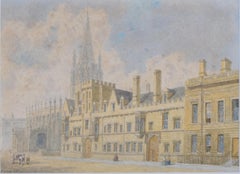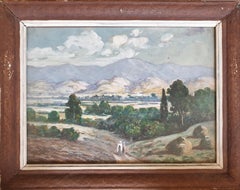'Ebren Ha Dor, Shifting Sky'. Contemporary Landscape, Rural, Countryside, Clouds
'Ebren Ha Dor, Shifting Sky'. Contemporary landscape painting, Cornwall
Original Artwork, Unframed
_________________
The dancing light and rapidly changing skies, hung high above the the landscape of West Cornwall: a harshly beautiful peninsula, jutting out into the wild tireless ocean, shaped and moulded by powerful salt laden Atlantic winds. Criss-crossed by ancient, tangled hedgerows marking the stories of the leathered, labour-roughened hands worn like the granite, coloured as the bronze bracken covered land they toiled endlessly to tame, carving spaces of sanctuary against the raw elements.
A plein air painting from the series 'Ebren ha Dor' (Meaning 'Sky and Earth in Cornish). In this series, Sophia's fluid expressive style captures the immediacy of the changing light in the seasonal landscapes, whilst exploring flux and balance in the nature of all things: The freedom of the air and solidity of the soil; Of human narratives written in the wild landscapes; in the sensual interplay of light and shadow. They capture an essence of the equilibrium between wild raw energy and serene stillness; chaos and harmony; and the enduring and the effervescent.
Acrylic ink on handmade rough edge watercolour paper
Signed in pencil to the lower right corner
30 x 30cm / 12 x 12 inches
__________________________
About The Artist
Sophia Milligan is a contemporary multidisciplinary artist, exploring discourses on permanence & evanescence; the eternal, cyclical absolutes of birth & death; motherhood & childhood; and ancient immutable connections. With resonating ripples of intuition and instinct Sophia illuminates the presence of the ordinary, creating moments of sublime present.
'Born among the wild cliffs and tempestuous seas of west Cornwall, I grew with the intimate details in the twisting lanes and the intense changing light throughout the turbulent seasons. I formed a primordial connection with a deep instinctual sense of being part of the natural narrative, and wherever in the world I may be, this connectivity underpins my practice. Like the wind sculpted hawthorns and sensual coves of weather worn granite, I have been shaped by the powerful energy entwined in this ancient raw environment.’
‘We are the stories of the journeys that came before. I weave into my work the tales of transitory circumstance; of struggle and survival; of forms and textures holding records of evolutionary millennia. I paint, I draw: with marks, mixtures, photography, words; the raw earth; the restless oceans; the whispered breeze. I work with time, and the immeasurable spaces of experience within, giving subtleties of existence a pause for contemplation. There is beauty in such poignant breaths. All moments are significant, every pebble of now forms the vast mountain of yesterday, and the great realm of tomorrow's possibilities'.
Sophia has a 1st class honours Bachelor of Arts Degree in Visual Arts and World History, and a Masters Degree in Contemporary Visual Arts. Her work is held in prestigious international private collections, and exhibitions of her interactive, immersive installation, photography and mixed media works include 'Tabula Rasa', London; 'Superlative', Plymouth; 'Transition', Newlyn; The Eden Project, Cornwall; The European Parliament, Brussels; Kew Gardens, London; and 'The Cameraless Film Festival', Chicago.
_________________________________
Modern . Landscape . Contemporary . landscape . Stone . Cornwall . Sky . Yellow . Blue . Green . Brown .
Rural...




